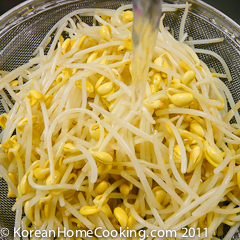
I originally made this sauce to use as a dressing for bibimbap but decided to make it a separate post. It is part of bibimbap recipe, but it goes well with many other dishes as well. You can mix in a spoonful of this beef chili paste sauce onto your rice for instant beef-chili-bibimbap, or use it as ssamjang for vegetables or BBQ. If you like the original Korean chili paste, I am sure you will like this even more.
Ingredients:
ground beef (1/2 lb)
cooking wine (3 tbl)
ground pepper (pinch)
chili paste (2 cup)
ginger (1 tbl, ground)
garlic (3 tbl, minced)
onion (1/2 chopped)
honey (4 tbl)
sesame oil (1 tbl)
ground sesame seeds (3 tbl)
1.
 Add cooking wine and pepper to ground beef and mix well. Stir fry the peppered ground beef and set it aside.
Add cooking wine and pepper to ground beef and mix well. Stir fry the peppered ground beef and set it aside.2.
 In a pot, mix the remaining ingredients together (chili paste, ground ginger, minced garlic, chopped onion, honey, sesame oil and ground sesame seeds) and boil.
In a pot, mix the remaining ingredients together (chili paste, ground ginger, minced garlic, chopped onion, honey, sesame oil and ground sesame seeds) and boil.3.
 When the sauce boils, add the ground beef from Step 1, reduce to low/medium heat and cook for another 5 to 10 minutes.
When the sauce boils, add the ground beef from Step 1, reduce to low/medium heat and cook for another 5 to 10 minutes.




















